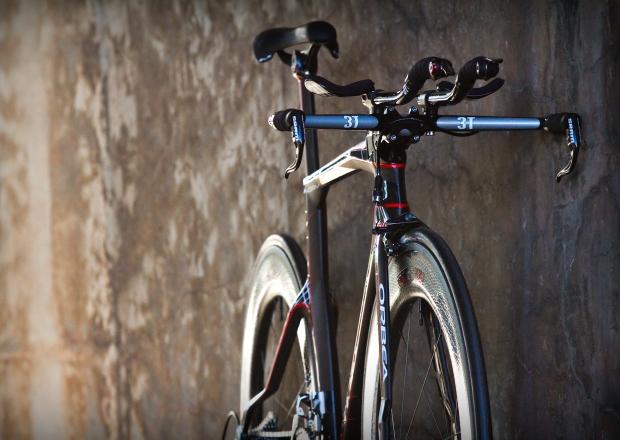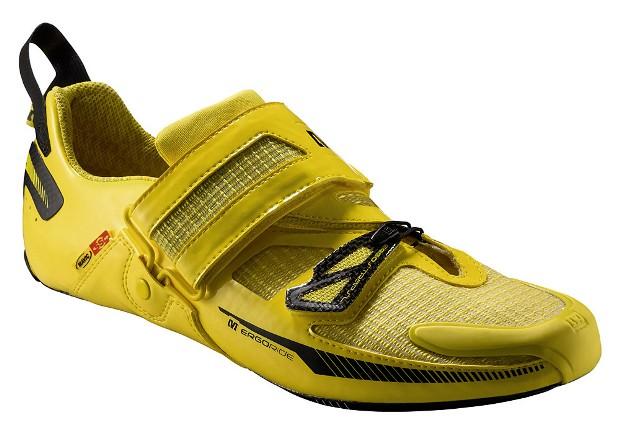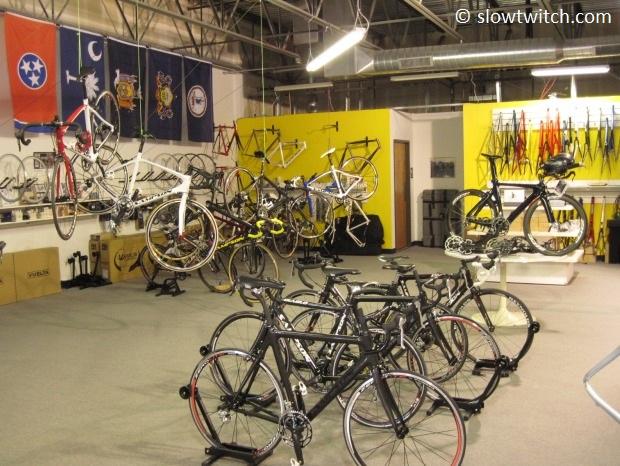Rudy Project 2013
Rudy Project has the tagline, ‘Technically Cool’. So, if you want to get technical about it… they’re cool. I think we can agree that it sounds more appealing than ‘Scientifically Rad’ – so we’ll go with it. The name Rudy Project actually happens to perfectly describe the company’s start. It was a project started in 1985 by an Italian man named Rudy Barbazza. His vision was to create the world’s most technologically advanced sports eyewear, and that has since grown to include helmets, (ski) goggles, and accessories.
This is an overview of the Rudy Project line for 2013. We take a broad look at the product line, and highlight a few key triathlon-specific products.
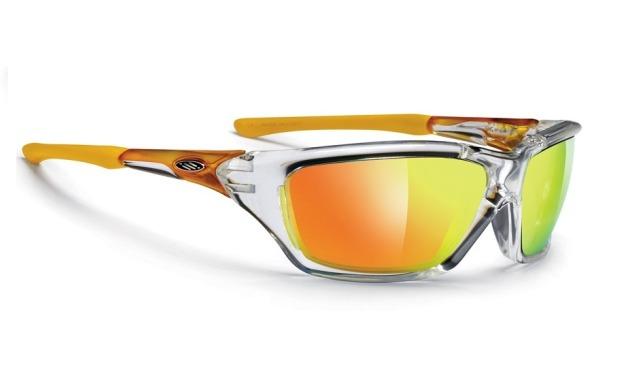
Back in my college days, our triathlon club had a pro-deal sponsorship with Rudy, and I purchased more than one pair of shades. Their look has always been unique, which could either be their greatest strength, or their Achilles heel. When I spoke with their US sports marketing manager, Chris Lupo, he told me that their distinctive style is definitely by-design. He said that they seek to compete on the merits of highest quality materials and best functional design. Whether you prefer the Rudy look or the Oakley look (or another brand entirely) is up to you.
Glasses
Rudy has a lot of sunglasses, so I’ll pare it down to the essentials. For triathlon, the key choice that ought to be made on the front end of a sunglass purchase is a simple one: Standard frame or frameless? Standard frames usually feature two separate lenses (one for the right eye, and one for the left eye), and attach via a frame on top. The frame also carries a nose piece, and has hinges for each earpiece on the sides. Most of Rudy’s glasses are this style. For example, this is their Ketyum model:
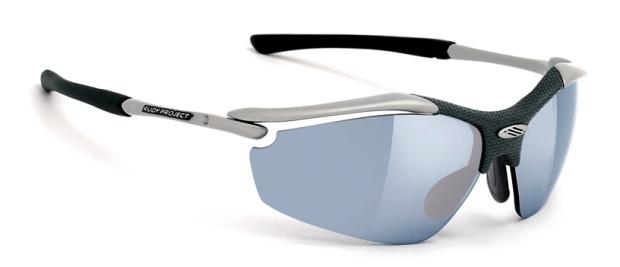
They’re simple and effective. While this type of sunglass works well for running and most sport activities, there is a potential problem with using them for cycling – especially when in the aero position. The lower your handlebars are, the more your head has to tilt up, and your eyes have to look up to see the road in front of you. Often times, the frame of a standard-style sunglass is smack dab in the middle of your field of vision. If this sounds familiar to you, look no further than a frameless pair of sunglasses.
With frameless glasses, the lens IS the frame. The nose piece and hinges attach directly to this single giant lens. Rudy has two models that are frameless – the Hypermask (pictured below) and the Karboneye.
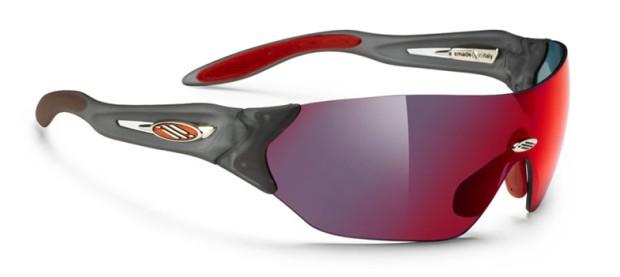
Rudy sent the Hypermask to me for evaluation, and they work well. The field of vision is great, and there is no frame in the way. Unfortunately, however, the lens does not seem to have the same level of clarity as the higher-end models with ImpactX lenses, which we will discuss below. The Karboneye does have the nicer lenses, although I didn’t have a chance to demo them.
I should note that Rudy Project technically has another ‘frameless’ model, called the Hypermask Performance. It is essentially the same design as the standard Hypermask, save one detail – there is a mini ‘frame’ in the middle of the brow:
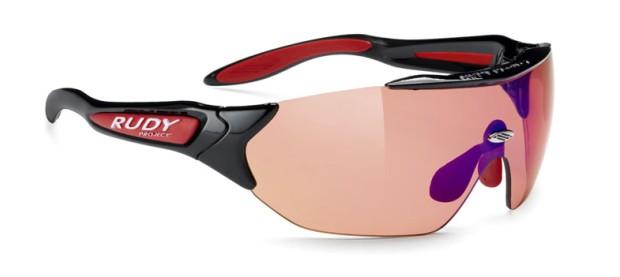
This mini frame piece is, in fact, functional. It has little vents, and its purpose is to push the sunglass lens away from your face, to resist fogging. I think they’re a great pair of shades for running, but the frame could make it a no-go for aero-position-riding, depending on whether it bothers you.
Sunglass Technology
Assuming you’re after a standard-style pair of shades (with a frame), your choices from here are nearly endless. Within each model of sunglasses, there are a multitude of options available. Note that not every single model has every single option; your best bet is to refer to Rudy’s website to see if the style you want has the technology or color you want. We’ll outline some of the key options below.
ImpactX
ImpactX is Rudy Project’s name for their extra-durable photochromic lenses. They’re said to be extra durable due to their materials and construction methods. Rather than being made from the typical polycarbonate, ImpactX lenses are made from polyurethane. I’m no chemist, so I have to take their word for it when they say it makes the lenses astoundingly strong. The good news for customers is the fact that all ImpactX lenses have a lifetime warranty against breakage or cracking. If you do manage to break them, you get new ones for free.
In addition to the super-strength component, ImpactX also includes their photochromic technology. In layman’s terms, that means that the lenses allow more light through when it’s dark outside, and allow less light through when it’s bright and sunny. Or, if you prefer pictures to words:
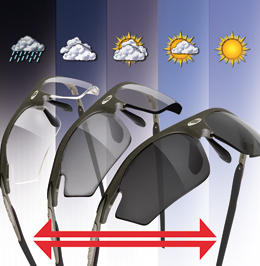
Rudy sent a pair of their Noyz shades with clear photochromic ImpactX lenses. I’d never tried automatic-tint-changing shades before, but thought it was worth a shot.
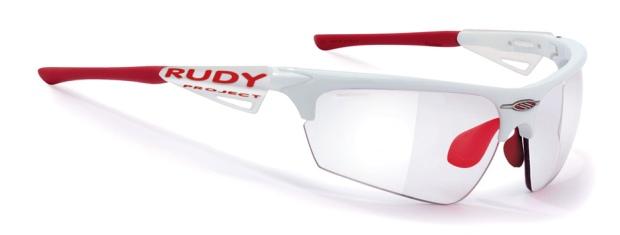
I found they worked really well. The tint changing works quickly, and the clarity is a big step up from the non-ImpactX lenses. These glasses have become a mainstay in my selection of shades, specifically for mountain biking. If you have trails that include both open areas of sunshine and shaded or wooded areas, they work wonders. When it’s getting dark out, the lenses become completely clear. In full sunlight, they don’t seem to offer quite as much protection as a standard dark sunglass would, but I think the compromise is well worth it. If I go out on a full-sunny ride, I just pick a different pair of non-photochromic glasses.
Impact Rx
Impact Rx is the same technology as ImpactX – but with the added option of matching your prescription glasses. The process is simple. Start by picking your sunglass style at Rudy’s website. In their online store, there is a section in which you enter your prescription information. Add the extra options you want, click ‘order’, and you can pick them up at your local eyeglass retailer.
And boy, are there options aplenty. Just out of curiosity, I decided to see how high I could price up a set of Rx shades. Start with the Ketyum frame at $285, add a set of photo polarized Rx lenses for $420, the upgraded anti-reflective coating for $100, and you’re looking at about $800 total. That’s some serious coin, but the purchase could be well worth it if you can’t wear contacts.
Polar3FX
Polar3FX is Rudy’s ‘super’ polarized lens. While many of their shades have an option for polarized lenses, only a handful can be had in Polar3FX. Additionally, the lens colors are limited to grey and brown. They key upgrade for this lens is its ability to resist glare better than their normal lenses. I know when to admit that I’m not an expert on a topic (in this case – not an optometrist), so here is the technology explained in Rudy’s own words:
“When light is reflected from a surface, it is partially polarized. When it is reflected at a particular angle, 53 degrees in the case of water, it is completely polarized. Whenever such light – GLARE – is viewed through a polarizer, it is completely eliminated. This glare produces eyestrain and discomfort. Tinted glass or plastic cannot solve the problem of glare. Polarized filters selectively absorb the reflected glare while transmitting useful light from a scene. This overall transmittance can be adjusted to reduce brightness to a comfortable level. Undesirable effects of glare are in increase in brightness and a reduction in color saturation. This makes objects viewed in the presence of glare appear washed-out.”
Rudy Project 2013 Helmets
Aside from sunglasses, Rudy Project makes a wide selection of helmets, including both road and TT/Tri-specific options.
It should also be noted that there are actually two designs of every single helmet model – a European-spec, and an American-spec. This can be easily seen if you compare the helmet weights between the American website and Global website – the American helmets weigh 30-70 grams more than their European equivalents, due to more stringent safety requirements.
In addition, you should know that Rudy Project offers only two sizes in most models – a Small/Medium (54-58cm in most models), and Large (59-62cm in most models). They tell me that due to the design of their retention system, this is all that is needed.
The helmet line starts with their bread-and-butter: the Sterling, at $260 and 350g (USA).

For my test lid, I opted for the super neon green, as you can see. Who wants a boring white or black helmet, when you can look like a Ninja Turtle? The helmet even matches my all-green custom TYR Special Ops goggles…
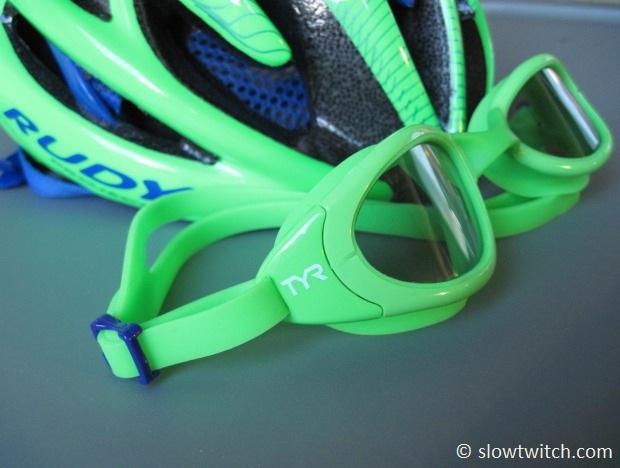
While I won’t argue my lack of writing ability – you can’t say that I don’t have a sense of taste.
The Sterling is Rudy’s best-selling helmet model, and for good reason. They say it fits more ‘American-style’ – which is to say, lower on the head. It actually cradles your noggin quite nicely, and is very comfortable. Part of the comfort is due in part to their very generous helmet pad and liner:
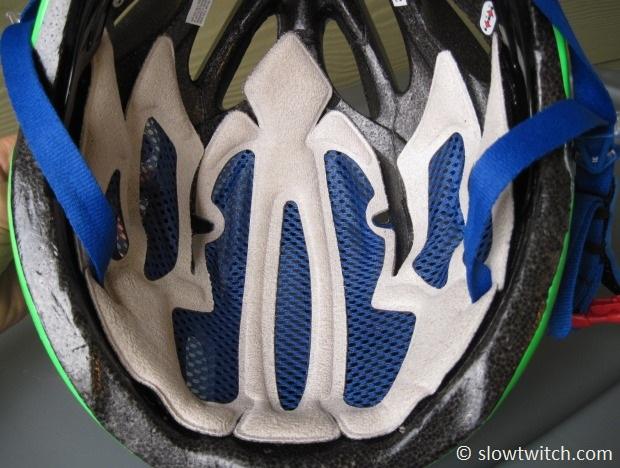
This liner looks as though it might make the helmet warmer to wear, but I was unable to tell much of a difference compared to other helmets.
I found the only potential downside of the Sterling to be the sizing. They say that this helmet works for head diameters of 59-61cm; most of their other helmets go up to 62. I’m just a touch under 59cm, and the helmet fits – but with little room to spare. I can just squeeze a thin headband in for cold days, but any sort of hat is out of the question. If your head is 60 or 61cm, you’d likely not be able to wear anything under the helmet.
Next up is their top-end Windmax, at $305 and 250 grams (USA). The Windmax is more of a ‘Euro’ fit; it sits higher on the head.
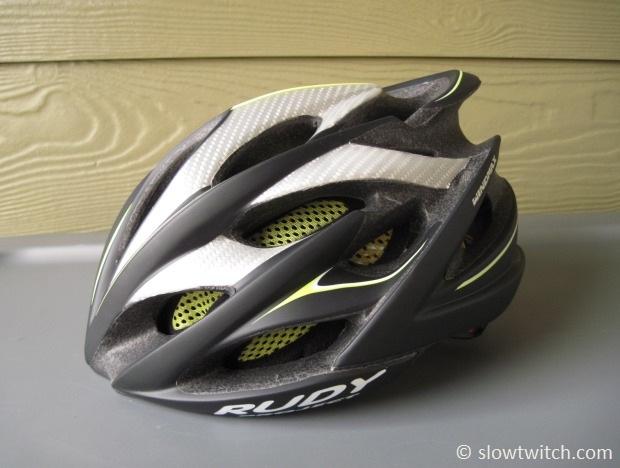
I found the large Windmax to fit bigger than the large Sterling, so it works better for cold weather hats. In general, it fit just fine, but was not as comfortable as the Sterling, which seemed to ‘hug’ my head better, and felt softer inside. Similar to buying shoes, however, comfort is always subjective and best evaluated in-person at a brick-and-mortar retail store.
Each Rudy Project helmet includes spare interior pads and a helmet bag. Most road-style helmets also include a visor for mountain biking. The top-end Windmax even includes two different style visors, of which I’m certain Batman would approve:
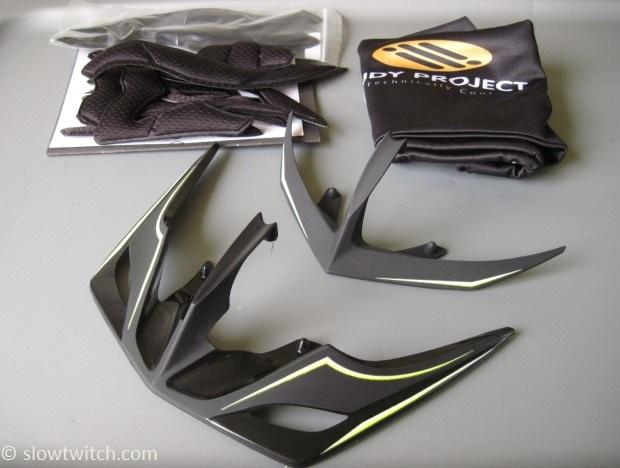
The helmet that you’re all probably curious about is their aero lid, the Wingspan, at $310 and 349g (US).
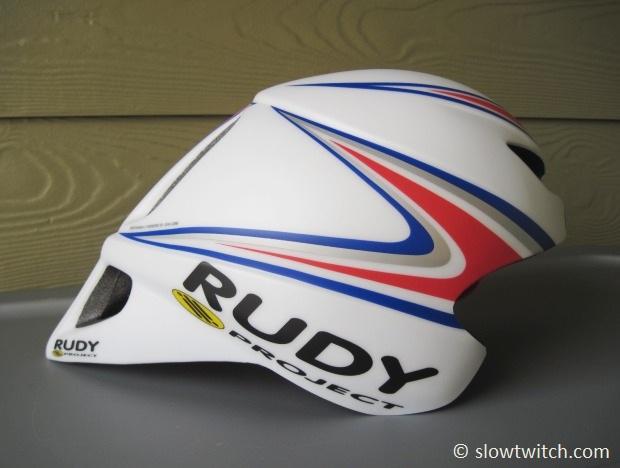
Rudy designed this helmet with the help of aerodynamics expert, John Cobb. They claim that the unique advantage of the Wingspan is the fact that it is not only fast, but that it is also very versatile and works well with different back shapes. Their testing showed that while there are a few specific cases where another helmet might be a few seconds faster for someone with a certain bike position or back shape, the Wingspan is faster for the vast majority of potential people and situations.
The Wingspan has a ‘mid-length’ tail, which Rudy claims does not need to be close to the rider’s back for maximum speed. The tail also has a removable fairing:
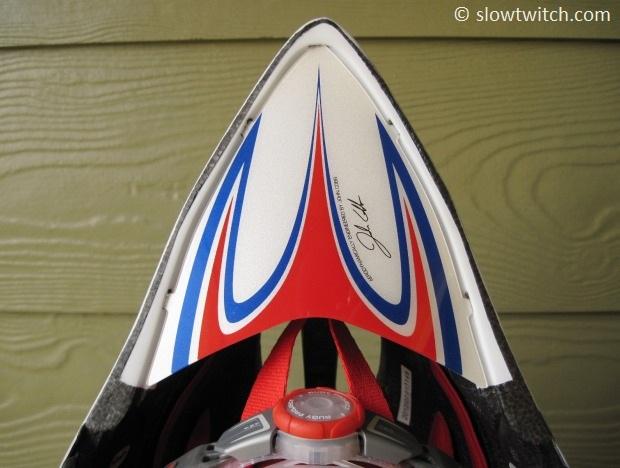
Also immediately obvious are a handful of large vents, which are said to offer great cooling properties.
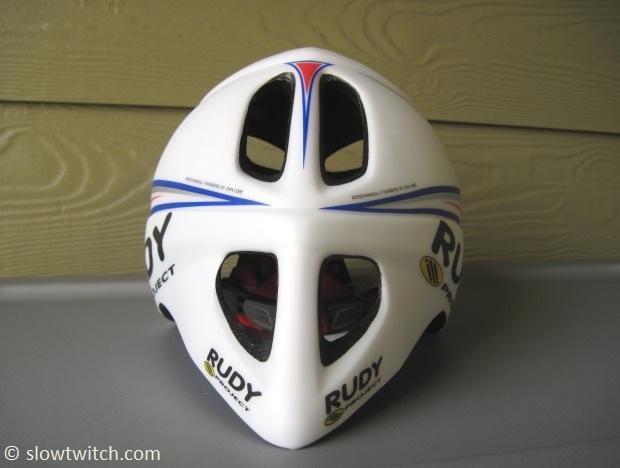
Rudy even includes two optional covers for the front vents, to customize your aero experience.
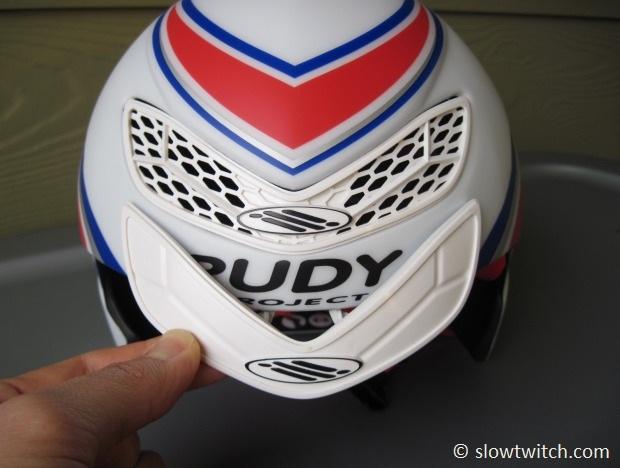
Just how fast is the Wingspan? Rudy offered an example based on the following protocol:
40k TT, ridden by an elite rider at 5 foot, 10 inches tall (178cm), 160 lbs (72.5kg), and averaging 390 watts. The ‘base’ time with a standard road helmet is 51:39, or 28.9mph (46.5kph). They do not mention a specific yaw angle; rather, they say that the helmet was tested at ‘various yaw angles’.
According to Rudy, swapping the road helmet for a Wingspan with open front vents brings the time down to 50:23. Adding the mesh vent cover drops another 10 seconds, to 50:13. The full closed vent makes it 50:10, or 29.7mph (47.8kph). The total potential savings is 1 minute 29 seconds, or 0.8 mph.
As you can see, the US-version of the Wingspan meets all CPSC safety requirements:
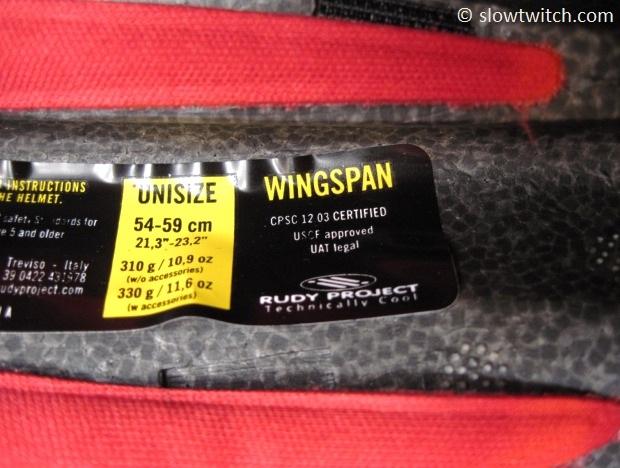
Unfortunately, I was unable to test the Wingspan. Similar to their other helmets, it is offered in a Small/Medium size, but there isn’t a large size available. Rudy Project representatives told me that the Sm/Md covers over ninety percent of their customers, and the cost of an additional mold for a Large was prohibitive. The published fit range for the Sm/Md is 54-59cm, which includes me, at just under 59cm. While I could technically fit the helmet on my head, it was a very tight squeeze, and not comfortable for riding any length of time. Due to the limited sizing, Rudy continues to offer their older-style Syton aero helmet in Large to accommodate those of us with big heads.
Kona Countin'
You may have seen that the Wingspan won the 2012 helmet count in Kona. You may have also seen that there was a fair amount of controversy surrounding this. I had heard that they won the count in 2011, and didn’t think much of it. This year, however, we saw photos of Rudy Project giving away free helmets just days before the big race. Some called it unfair; others said that they’re just running a smart business. I wanted to find out more – what’s the story behind the story?
According to Rudy Project’s global marketing and sponsorship agent, Thomas Vonach, they were not giving helmets away to just anyone. Rather, each of those people picking up helmets had filled out a sponsorship application well in advance of the race, and were simply picking up their sponsored product. In order to take the helmet, they had to sign a contract that obligates them to ride it for a complete year. It just so happens that anyone who qualifies for Kona is automatically accepted for the sponsorship, and you could say that the product distribution is done at a ‘convenient’ time.
Whatever your opinion is of the situation, it’s hard to argue their cleverness. Most other companies sponsor athletes; perhaps they will start timing their product distribution to fall right before Hawaii. That may raise a very fundamental question: What is the intent of the big annual product count? What are we trying to measure? Brands’ market penetration, cleverness, or something else entirely? Whatever the case, we’d love to hear your thoughts on it, and anticipate hearing more about this issue come October 2013.
Helmet counting aside, we hope you enjoyed this overview of Rudy Project’s 2013 line. If the glasses fit your style preferences, they have just about every option under the sun to suit your needs. The helmets are nice quality, but it seems that they cater more towards small heads. The Wingspan, specifically, seems to have a good reputation for comfort and venting. If the aero claims are true, it could be among your best aero helmet choices.



